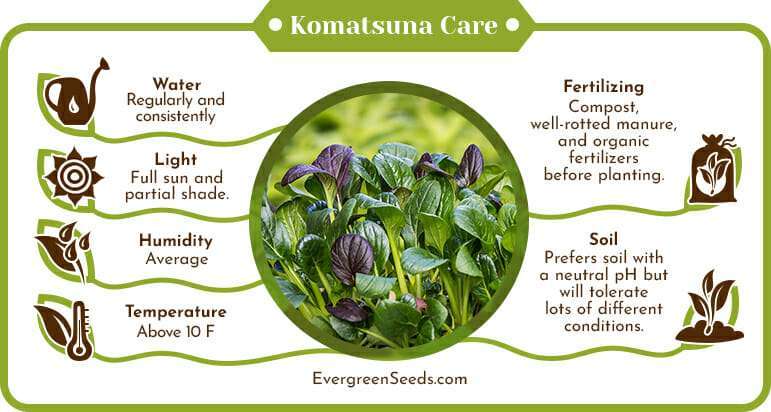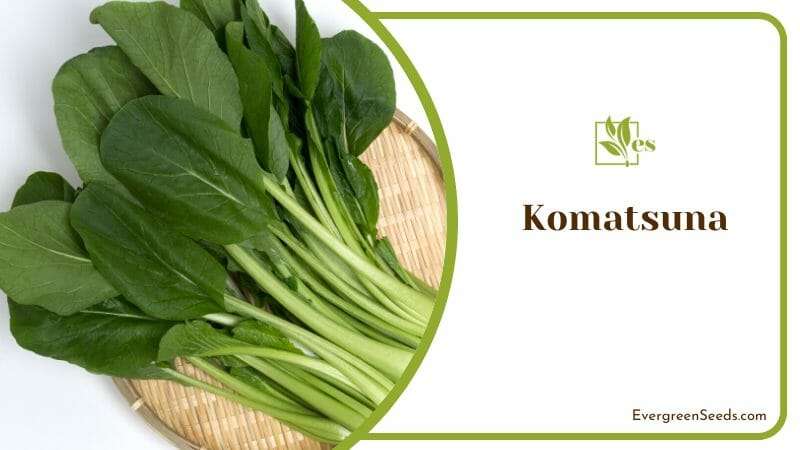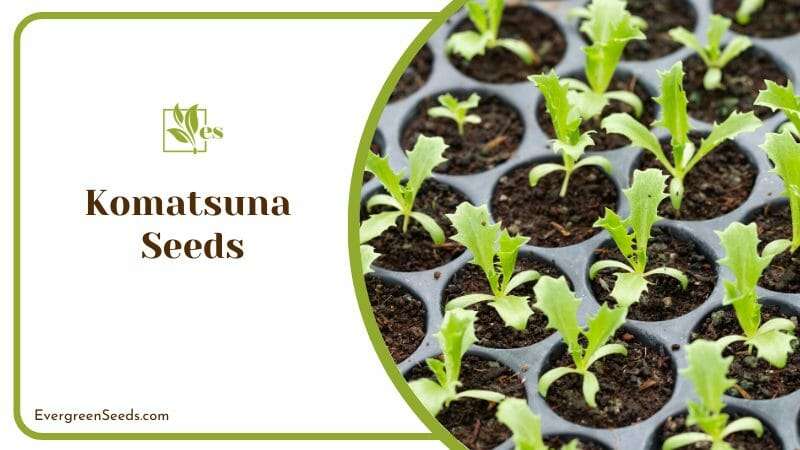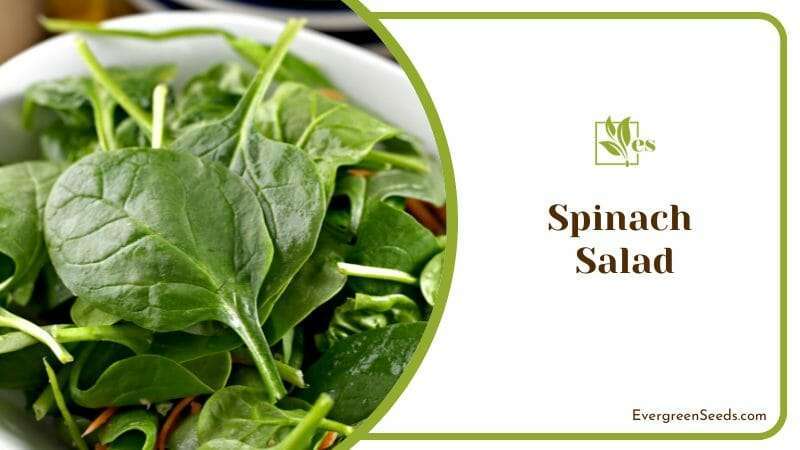- When Are Raspberries Ready to Pick: A Comprehensive Guide for Gardeners - July 11, 2024
- When Are Red Delicious Apples Ready to Pick: Essential Harvesting Tips - July 11, 2024
- When Are Snow Peas Ready to Pick: Essential Harvest Tips - July 11, 2024
 Komatsuna of the Brassicaceae family is also known as mustard spinach or Japanese mustard, and it’s a beautiful addition to your garden. Komatsuna is a fast-growing green of the Brassica genus you can enjoy year-round in many parts of the United States.
Komatsuna of the Brassicaceae family is also known as mustard spinach or Japanese mustard, and it’s a beautiful addition to your garden. Komatsuna is a fast-growing green of the Brassica genus you can enjoy year-round in many parts of the United States.
You can learn to grow tasty komatsuna greens at home using this guide.
We will give you all the information you need about how to plant, when and where komatsuna plants grow best, and how to harvest and enjoy your komatsuna mustard spinach.
JUMP TO TOPIC
What is Komatsuna?
Komatsuna is a lesser-known green in the brassica family, including turnips, bok choy, and napa cabbage. Komatsuna gets its unusual name from an interesting story. A Shogun, one of Japan’s ancient warlord kings, was served a tender, spicy green when he visited a temple in 1719. He named the vegetable after the Komatsu River running through the village.
 Today, dozens of varieties of komatsuna are available for both commercial and home gardeners.
Today, dozens of varieties of komatsuna are available for both commercial and home gardeners.
Varieties have been developed that mature quicker, grow in extreme heat and cold, and provide tender, flavorful leaves you can eat raw or in many dishes.
Komatsuna is rarely available in grocery stores in the United States, but it is becoming a popular choice for home gardeners.
What Does Komatsuna Taste Like?
The flavor of komatsuna is compared to many other types of greens, but it’s spicy, mustard green-like flavor is how it became known as Japanese mustard spinach.
Young komatsuna leaves are often added to salads for a flavorful kick. Mature leaves are most commonly used in stir fry and other Asian-inspired dishes but are also delicious fresh.
Komatsuna is milder than rocket greens, and many people comment on its cabbage-like sweetness and tender crunchiness.
Komatsuna is a popular addition to soups because the leaves do not become mushy when cooked. They hold their texture well, even when other Asian vegetables fall apart.
How to Grow Mustard Spinach
Now that you know what komatsuna is and what it takes like, you probably want to know how to grow it.
There are lots of tips and tricks out there that will help you grow strong, healthy komatsuna.
We will share everything with you that professional gardeners growing komatsuna knows, so you can get the best crop of greens you’ve ever grown.
– Selecting Varieties of Komatsuna
There are lots of different varieties of komatsuna you can grow at home.
Some of our favorite varieties include:
- Summerfest: a hybrid variety cultivated for growing in warm climates, but they also do great in cooler weather. This hybrid is easy to grow type recommended for beginners.
- Tora-san: an ideal choice for gardeners who want a fast-growing variety that also produces for a long time. You can harvest leaves as you want them, and the plant will continue to produce long after other types have perished.
- Red Leaf: a real gem in the garden, this hybrid variety grows a beautiful red-purple with delicate, light green stems. It’s as flavorful as it is attractive.
- Sharaku: a Japanese hybrid variety perfect for US growers because it tolerates both hot and cold weather, and it’ll even handle temperatures as low as 10 degrees F. It’s known as one of the most prolific producers of all varieties.
The broad range of varieties available means that growers in the US can select the perfect seeds to grow the type of komatsuna mustard spinach greens they want. Gardeners will have the best selection of varieties by visiting seed sellers online.
Many varieties have specific planting time requirements, so it’s a good idea to make sure you buy seeds for a variety that grows during the season you want.
– Starting Komatsuna Seeds
You can start Japanese mustard spinach seeds indoors or directly sown in your garden. The seeds should be planted after the last frost for early varieties or after the peak of summer heat for later maturing types of komatsuna.

Seeds can be started indoors four to six weeks before the last frost or a few weeks before you are ready to plant.
 Soil Conditions for Growing Japanese Mustard Spinach
Soil Conditions for Growing Japanese Mustard Spinach
Komatsuna prefers soil with a neutral pH but will tolerate lots of different conditions.
Gardeners should work in compost with the soil before planting to encourage healthy root development. Komatsuna doesn’t require lots of fertilizer, but using a water-soluble fertilizer before planting is a great way to start young plants.
If you are directly sowing seeds in your garden, deposit seeds in soil ¼” to ½” deep.
Seedlings started indoors should be hardened off for a few days before transplanting into soil. Komatsuna can be planted closer together for smaller plants or farther apart for larger ones. A 6″ spacing is typically ideal for most varieties.
– Planting in Containers
Komatsuna does exceptionally well in containers and planter boxes. A mixture of potting soil and compost will provide an excellent start for komatsuna. Adding perlite can help improve drainage, but it’s essential to avoid letting soil drain too quickly.
Komatsuna plants grow fairly deep roots, so a planter box that is 10 to 12 inches deep is ideal for growing healthy plants.
 How to Water Komatsuna
How to Water Komatsuna
Like many other leafy green vegetables, komatsuna needs to be regularly watered. The plants prefer moist soil that is watered deeply to encourage root growth. Avoid overwatering and spraying water onto leaves to prevent fungal and bacterial infections.
Komatsuna should be watered consistently to avoid stressing the plant.
 Light Conditions
Light Conditions
Japanese mustard spinach likes full sun and a little afternoon shade. It will tolerate cold temperatures better than heat. In regions where afternoon temperatures are above 80 degrees, shade cloth can help protect komatsuna leaves from wilting. Komatsuna will start to flower when temperatures are too high. This method is called bolting, and you should avoid it because the plant will stop producing leaves.
One of the wonderful things about growing komatsuna is that the plants are very hardy and tolerant of cold climates. Gardeners can grow komatsuna throughout the US, with many varieties able to produce greens well into winter. Komatsuna can’t handle a hard frost, though, so be prepared with covers if you grow mustard spinach in places where freezes are common.
– Replanting Komatsuna Next Season
Japanese mustard spinach will deplete nutrients in the soil. It’s a good idea to amend soil each year when replanting to prevent komatsuna plants from leaching the soil of nutrients. Compost, well-rotted manure, and organic fertilizers can help keep your garden soil healthy and ready for new plants.
It’s a good idea to rotate brassica plants like komatsuna every few seasons with other plants types. Crop rotation will help to prevent nutrient loss in your garden. Peas, beets, and onions are good choices to plant when you are rotating your komatsuna plants.
How to Harvest Mustard Spinach
Unlike many other leafy green vegetables similar to komatsuna, you can harvest leaves individually, and the plant will continue to grow. You can even chop off the head, leaving the roots in the soil, and the plant will regrow. We recommend a sharp, clean knife for harvesting leaves.
Komatsuna greens mature very quickly. You can harvest some varieties in only a month after planting. Experienced komatsuna gardeners plant several times each season to provide long-term harvests of delicious Japanese mustard spinach greens.
Using Komatsuna Greens
Leaves of the komatsuna are delicious when used in a stir fry. The slightly spicy flavor lends well to any dish where vegetable greens are used, and they are outstanding in soups. You can also eat young leaves in salads raw.

Komatsuna leaves are pickled in some cultures, and they are excellent
Pests and Diseases that Harm Komatsuna
There are lots of different pests and diseases that can destroy your komatsuna plants.
Gardeners should learn to identify signs of problems to prevent problems from getting out of hand. The best thing gardeners can do is start with clean soil free of fungi and bacteria and good-quality, healthy seeds.
– Pests that Harm Komatsuna Mustard Spinach
Unfortunately for the home gardener, almost every harmful pest out there will eat komatsuna. A few of the most common pests are flea beetles, aphids, caterpillars, and slugs. Row cover can help to prevent many insects from infesting your garden. Excellent organic methods for controlling insects are diatomaceous earth sprinkled on dry plants and the soil and a spray of 70% neem oil.
– Common Komatsuna Diseases
Komatsuna is relatively resistant to many diseases. The most common diseases are caused by improper watering when leaves are left wet, or soil is overwatered. Leaf spot shows up as dark spots on leaves, eventually killing the Leaf. Downy mildew can be a problem for gardeners also. Downy mildew looks like whitish fuzz on the bottoms of leaves that ultimately leads to spots on the surface.
At the first sign of any disease, gardeners need to remove damaged leaves. Do not put plants in your compost if they show fungal or bacterial infection. Just throw them in the garbage. You can cut leaves off your komatsuna plants most of the time when they show signs of the problem.












